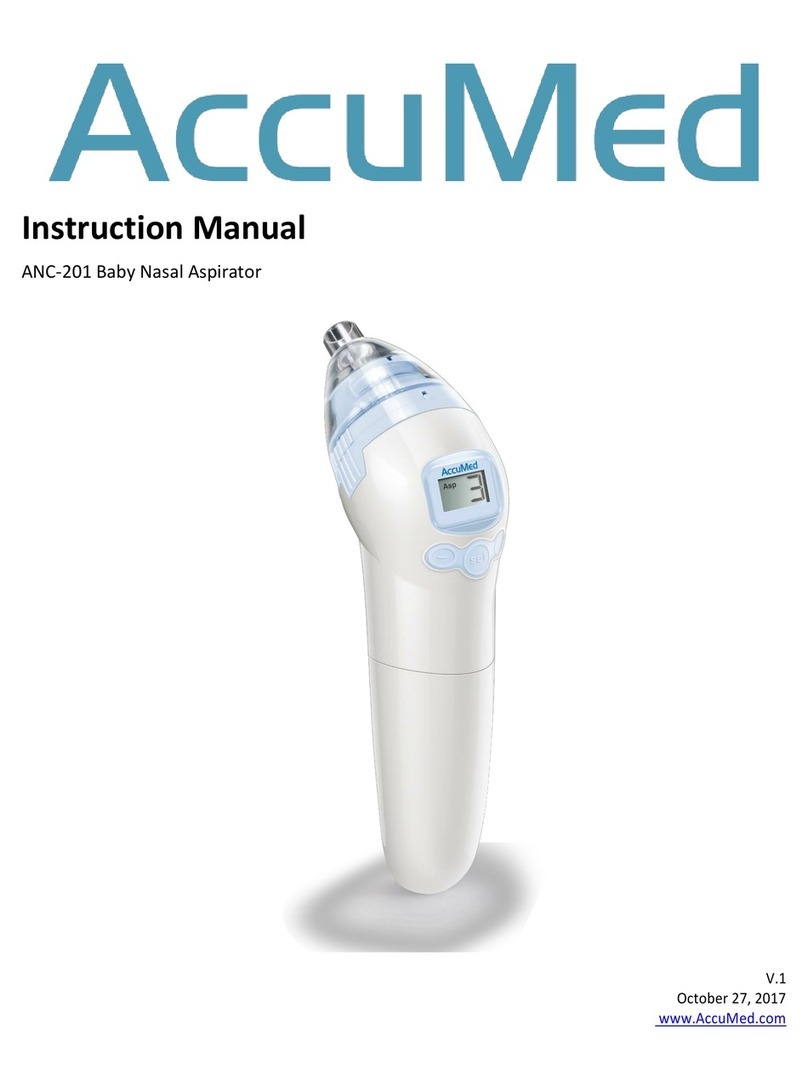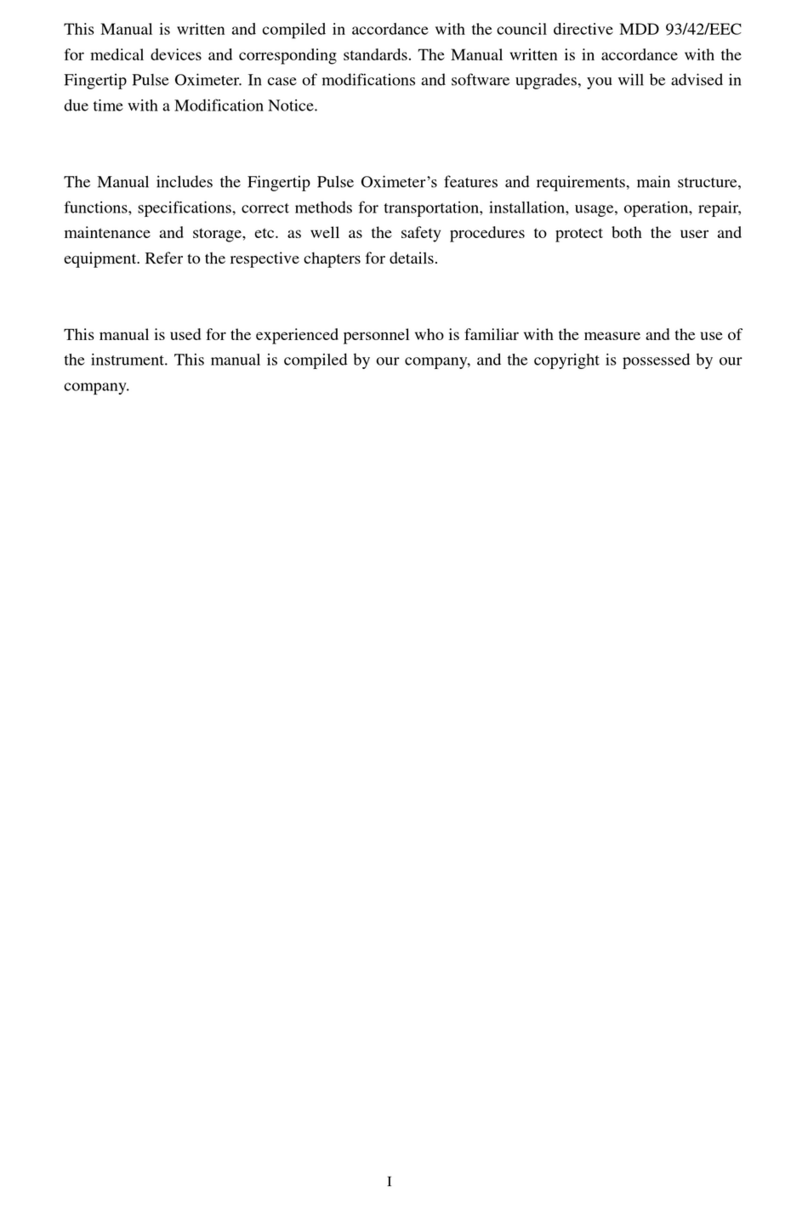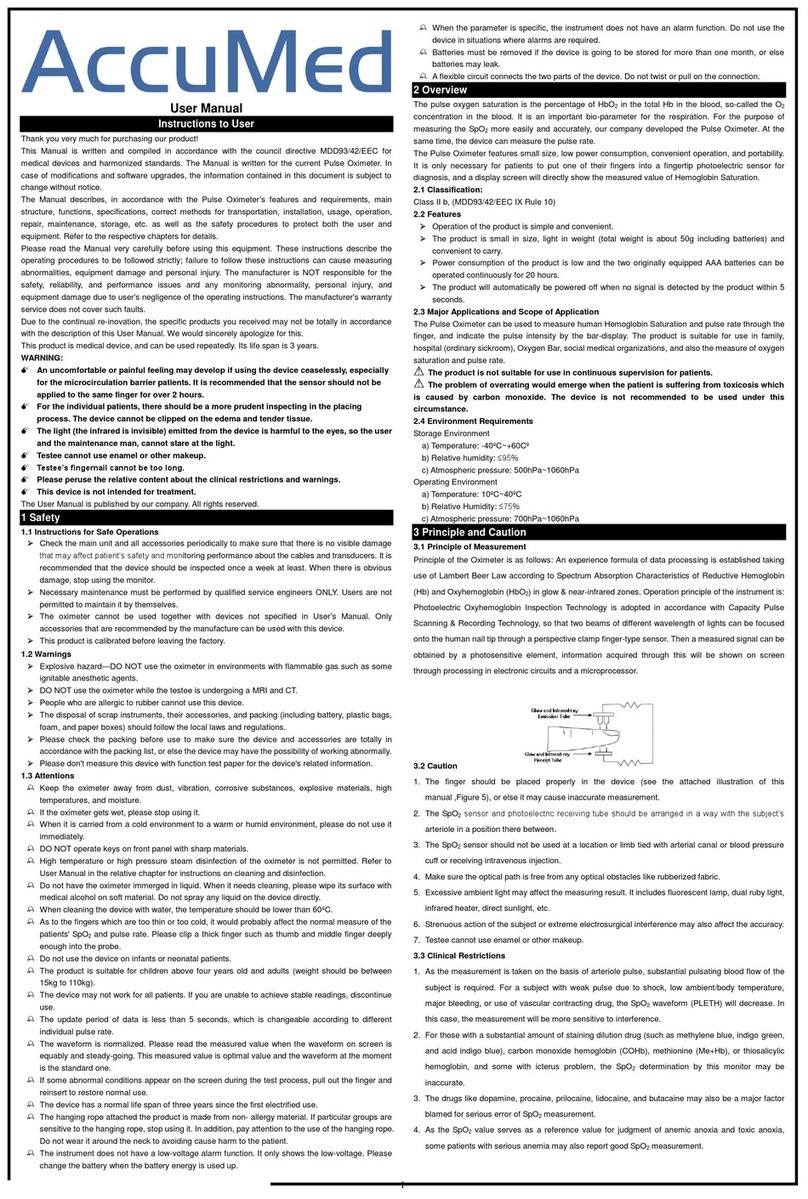User Manual
Instructions to User
Thank you very much for purchasing our product!
This Manual is written and compiled in accordance with thecouncil directive MDD93/42/EEC for medical
devices and harmonized standards. The Manual is written for the current Pulse Oximeter. In case of
modifications and software upgrades, the information contained in this document is subject to change
without notice.
The Manual describes, in accordance with the Pulse Oximeter’s features and requirements, main
structure, functions, specifications, correct methods for transportation, installation, usage, operation,
repair, maintenance and storage, etc. as well as the safety procedures to protect both the user and
equipment. Refer to the respective chapters for details.
Please read the Manual very carefully before using this equipment. These instructions describe the
operating procedures to be followed strictly; failure to follow these instructions can cause measuring
abnormality, equipment damage and personal injury. The manufacturer is NOTresponsible for the safety,
reliability and performance issues and any monitoring abnormality, personal injury and equipment
damage due to user’s negligence of the operation instructions. The manufacturer’s warranty service does
not cover such faults.
Due to continual re-inovation, the products you received may not be totally in accordance with the
description of this User Manual.We would sincerely regret for that.
This product ismedical device, and can be used repeatedly.
WARNING:
An uncomfortable or painful feeling may develop if using the device ceaselessly, especially
for the microcirculation barrier patients. It is recommended that the sensor should not be
applied to the same finger for over 2 hours.
For the individual patients, there should be a more prudent inspection in the measured part.
The device cannot be placed on the edema and tender tissue.
The light (the infrared is invisible) emitted from the device is harmful to the eyes, so the user
and the maintenance man, cannot stare at the light.
Testee cannot use enamel or other makeups.
Testee’s fingernail should not be too long.
Please peruse the relative content about the clinical restrictions and caution.
This device is not intended for treatment.
The User Manual is published by our company. All rights reserved.
1 Overview
The pulse oxygen saturation is the percentage of HbO2in the total Hb in the blood, so-called the O2
concentration in the blood. It is an important bio-parameter for the respiration.
Many respiratory diseases will cause the body’s SpO2to decrease, while the body automatic adjustment
disorder caused by the anesthesia, big surgery trauma, and some of the damage caused by medical
examination, are likely to lead to patient’s oxygen supply problems and reduce the body’s SpO2, resulting
in patient dizziness, weakness, vomiting and othersymptoms. Severe cases will threaten life. So knowing
the patient’s SpO2 in time will help doctor which has great significance in clinical medical area.
The Pulse Oximeter features a small size, low power consumption, convenient operation, and portability.
It is only necessary for patient to put one of his fingers into a fingertip photoelectric sensor for diagnosis.A
displayscreen will directly showmeasured value of Hemoglobin Saturation.
1.1 Features
Simple and convenient operation.
The product is small in size, light in weight, and convenient to carry.
Low power consumption.
1.2 MajorApplications and Scope ofApplication
The product is applicable for use in family, hospital, oxygen bar, community medical treatment and sport
health care (it is advised to be used before and after sports and it is not suggested to be used in the
process of sport),etc.
The product is not suitable for use in continuous supervision for patients.
The problem of overrating would emerge when the patient is suffering from toxicosis which is
caused by carbon monoxide. The device is not recommended to be used under this
circumstance.
1.3 Environment Requirements
StorageEnvironment
a) Temperature: -40ºC~+60ºC
b) Relative humidity: ≤95%
c) Atmospheric pressure: 500hPa~1060hPa
Operating Environment
a) Temperature: 10ºC~40ºC
b) Relative Humidity: ≤75%
c) Atmospheric pressure: 700hPa~1060hPa
1.4 Safety
1.4.1 Instructions for Safe Operations
Check the main unit and all accessories periodically to make sure that there is no visible damage
that may affect patient’s safety and monitoring performance. It is recommended that the device
should be inspected once a week at least. When there is obvious damage, stop using it.
Necessary maintenance must be performed by qualified service engineers ONLY. Users are not
permitted to maintain it by themselves.
The oximeter cannot be used together with devices not specified in User’s Manual. Only accessories
that are recommended by the manufacture can be used with this device.
This product has been calibrated before leaving the factory.
1.4.2 Warnings
Explosive hazard—DO NOT use the oximeter in environment with flammable gas such as some
ignitable anesthetic agents.
DO NOTuse the oximeter while the testeeis undergoing a MRI or CT.
The person who is allergic to the rope cannot use this device.
The person who is allergic to rubber cannot use this device.
The disposal of scrap instrument and its accessories and packing (including battery, plastic bags,
foams, and paper boxes) should follow the local laws and regulations.
Please check the packing before use to make sure the device and accessories are in accordance
with the packing list, or else the device may have the possibility of working abnormally.
Please don’t measure this device with function test paper for the device’s related information.
1.4.3 Attentions
Keep the oximeter away from dust, vibration, corrosive substances, explosive materials, high
temperature, and moisture.
If the oximeter gets wet, please stop operating it.
When it is carried from cold environment to warm or humid environment, please do not use it
immediately.
DO NOToperate keys on front panel with sharp materials.
High temperature or high pressuresteam disinfection of the oximeter is not permitted. Refer to User
Manual in the relative Chapter for instructions of cleaning and disinfection.
Do not have the oximeter immerged in liquid. When it needs cleaning, please wipe its surface with
medical alcohol by soft material. Do not spray any liquid on the devicedirectly.
When cleaning the device with water, the temperature should be lower than 60ºC.
As to the fingers which are too thin or too cold, it would probably affect the normal measure of the
patients’ SpO2and pulse rate. Please clip the thick finger such as thumb and middle finger deeply
enough into the probe.
Do not usethe device on infants orneonatal patients.
The product is suitable for children above four years old and adults (Weight should be between 15kg
to 110kg).
The device may not work for all patients. If you are unable to achieve stable readings, please stop
using.
The update period of data is less than 5 seconds, which is changeable according to different
individual pulse rate.
The waveform is normalized. Please read the measured value when the waveform on screen is
equably and steady-going. Here this measured value is the optimal value. And the waveform at the
moment is the standard one.
If some abnormal conditions appear on the screen during test process, pull out the finger and
reinsert to restore normal use.
The device has normal life span of three years since the first electrified use.
The hanging rope attached the product is made from Non-allergy material. If a particular group is
sensitive to the hanging rope, stop using it. In addition, pay attention tothe use of the hanging rope.
Do not wear it around theneck to avoid causing harm to the patient.
The instrument doesn’t have a low-voltage alarm function. It only shows the low-voltage. Please
change the battery when the battery is dead.
The device doesn’t have an alarm for exceeding a limit. Do not use the device in situations where
alarms are required.
Batteries must be removed if the device is going to be stored for more than one month, or else
batteries may leak.
A flexible circuit connects the two parts of the device. Do not twist or pull on the connection.
2 Principle of Measurement
Figure 1 Operating principle
Principle of the Oximeteris as follows: An experience formulaof thedata processis established taking
use of Lambert Beer Law according toSpectrum Absorption Characteristics of Reductive Hemoglobin (Hb)
and Oxyhemoglobin (HbO2) in glow & near-infrared zones. Operation principle of the instrument is:
Photoelectric Oxyhemoglobin Inspection Technology is adopted in accordance with Capacity Pulse
Scanning & Recording Technology, so that two beams of different wavelength of lights can be focused
onto human nail tip through perspective clampfinger-type sensor. Then measured signal can be obtained
by a photosensitive element, information acquired through which will be shown on screen through
treatment in electronic circuits and microprocessor.
3 Technical Specifications
3.1 Main Performance
1) SpO2value display.
2) Pulse rate value, bar-graph display.
3) Pulse waveform display.
4) Low battery indication: When the voltage is too low to work, the battery capacity indication appears.
5) Automatically power off function: The product will automatically be powered off when there is no
signal within 5 seconds.
6) Display format can be changed.
3.2 Main Parameters
1) SpO2Measuring
Range:0%~100%
Accuracy: ±2% in stage of 70%-100% SpO2, and meaningless when stage beingsmaller than 70%
2) Pulse Rate Measuring
Range: 30 bpm -250 bpm
Accuracy:±2 bpm or±2% (select larger)
3) Resolution: 1% for SpO2and 1 bpm for Pulse Rate.
4) Resistance to surrounding light: The deviation between the value measured in the condition of
man-made light or indoor natural light and that of darkroom is less than ±1%.
5) Working voltage: DC 2.6V~3.6V.
4 Installation
4.1 View of the Front Panel
Figure 2 Front view
4.2 Battery Installation
1) Refer to Figure 3 and insert the two AAAsize batteries properly in the right direction.
2) Replace the cover.
Please take carewith the batteries as improper insertion maydamagethe device.






















